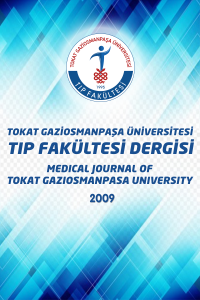Alopesi Areata’da IL–17 Promotör Polimorfizminin (-152 G/A) Araştırılması
Alopesi areata, IL–17, Otoimmünite, Polimorfizm
Investigation of IL–17 promoter polymorphism (-152 G/A) in alopecia areata
Alopecia Areata, Autoimmunity, IL–17, Polymorphism,
___
- 1. Xing L, Dai Z, Jabbari A, Cerise JE, Higgins CA, Gong W, et al. Alopecia areata is driven by cytotoxic T lymphocytes and is reversed by JAK inhibition. Nat Med. 2014; 20(9):1043–1049.
- 2. Dai Z, Xing L, Cerise J, Wang EH, Jabbari A, de Jong A, et al.CXCR3 Blockade Inhibits T Cell Migration into the Skin and Prevents Development of Alopecia Areata. J Immunol 2016; 197(4):1089-99.
- 3. Kim SK, Park HJ, Chung JH, Kim JW, Seok H, Lew BL, et al. Association Between Interleukin 18 Polymorphisms and Alopecia Areata in Koreans. Journal Of Interferon & Cytokıne Research 2014;34( 5).
- 4. Han YM, Sheng YY, Xu F, Qi SS, Liu XJ, Hu RM, et al. Imbalance of T-helper 17 and regulatory T cells in patients with alopecia areata. Journal of Dermatology 2015; 42: 981–988.
- 5. Zhang X, Zhao Y, Ye Y, Li S, Qi S, Yang Y, et al. Lesional infiltration of mast cells, Langerhans cells, T cells and local cytokine profiles in alopecia areata. Arch Dermatol Res 2015; 307:319–331.
- 6. Bodemer C, Peuchmaur M, Fraitaig S, Chatenoud L, Brousse N, Prost Y. Role of Cytotoxic T Cells in Chronic Alopecia Areata. J Invest Dermatol 2000; 114: 112–116.
- 7. Chen J, Deng Y, Zhao J, Luo Z, Peng W, Yang J, et al. The Polymorphism of IL-17 G-152A was Associated with Childhood Asthma and Bacterial Colonization of the hypopharynx in bronchiolitis. J Clin Immunol 2010; 30:539–545.
- 8. Kim BS, Park YJ, Chung Y. Targeting IL-17 in autoimmunity and inflammation. Arch. Pharm. Res. DOI 10.1007/s12272-016-0823-8.
- 9. Aytekin N, Akcali C, Pehlivan S, Kirtak N, Inaloz S. Investigation of interleukin-12, interleukin-17 and interleukin-23 receptor gene polymorphisms in alopecia areata. Journal of International Medical Research 2015; 43(4): 526–534.
- 10. Elela MA, Gawdat HI, Hegazy RA, Fawzy MM, Abdel Hay RM, Saadi D, et al. B cell activating factor and T-helper 17 cells: possible synergistic culprits in the pathogenesis of Alopecia Areata. Arch Dermatol Res. 2016; 308:115–121.
- 11. Tojo G, Fujimura T, Kawano M, Ogasawara K, Kambayashi Y, Furudate S, et al. Comparison of Interleukin-17- Producing Cells in Different Clinical Types of Alopecia Areata. Dermatology 2013;227:78–82.
- 12. Atwa MA, Youssef N, Bayoumy NM. T-helper 17 cytokines (interleukins 17, 21, 22, and 6, and tumor necrosis factor-a) in patients with alopecia areata: association with clinical type and severity. International Journal of Dermatology 2016; 55: 666–672.
- 13. Lew BL, Cho HR, Haw S, Kim HJ, Chung JH, Sim WY. Association between IL17A/IL17RA Gene Polymorphisms and Susceptibility to Alopecia Areata in the Korean Population. Ann Dermatol. 2012;24(1):61-5.
- 14. Alli R, Nguyen P, Boyd K, Sundberg JP, Geiger TL. A mouse model of clonal CD8(+) T lymphocyte-mediated alopecia areata progressing to alopecia universalis. J Immunol 2012; 188: 477–486.
- 15. Ito T, Tokura Y. The role of cytokines and chemokines in the T-cell-mediated autoimmune process in alopecia areata. Experimental Dermatology, 2014; 23: 787–791.
- ISSN: 1309-3320
- Başlangıç: 2009
- Yayıncı: Tokat Gaziosmanpaşa Üniversitesi
Primer Akciğer Tümörü Olan Beyin Metastazlı Olgularda Beyin Difüzyon MRG’nin Tanıya Katkısı
Mustafa Devran AYBAR, Yeşim KARAGÖZ, İşılay IŞIK, Halide Nur ÜRER
Akciğer Kanseri Beyin Metastazı Sonrası Serebral Enfarktüs
Mehmet Murat DİŞÇİ, Fatih Ersay DENİZ, Erol ÖKSÜZ, Özgür DEMİR
Anadolu’da Uygulanan Halk Tedavilerinden Bazı Örnekler
Alopesi Areata’da IL–17 Promotör Polimorfizminin (-152 G/A) Araştırılması
Nihan BOZKURT, Sümeyye Deniz ÇELİK, Ömer ATEŞ, Saime SEZER SONDAŞ, Emel ENSARİ, Göknur KALKAN
Türk Popülasyonunda Agresif Periodontitis ile Kök Anomalisi Arasındaki İlişkinin Değerlendirilmesi
Zeliha UĞUR AYDIN, Gülbahar USTAOĞLU, Pınar Gökçen YÜCESAN
Uzamış Priapizmli Olgularda (>36 saat) Tedavi Yaklaşımları
Fikret ERDEMİR, Bekir Süha PARLAKTAŞ, Mete KİLCİLER
Kadınlarda Alt Üriner Sistem Semptomlarının Nadir Bir Nedeni Mesane Taşları: Bir Olgu Sunumu
Engin KÖLÜKÇÜ, Yahya DOĞANAY, Murat BEYHAN, Fatih FIRAT, Bekir Süha PARLAKTAŞ, Hacı Ahmet SÜMBÜL, Mehmet İlhan YILDIZ, Velid ÜNSAL
